Even with the plush pillows, clean sheets, and blackout curtains, falling asleep in a hotel room can be tricky – at least for the first night. Trouble sleeping away from home, in a bed that is not your own, is more than just the result of a change in scenery. In fact, our brains simply won’t shut off. When sleeping in a new place, the left side of our brain remains alert, completely changing our sleep habits and making it nearly impossible to get a quality night’s rest. Luckily, this effect is only seen on the first night (the phenomenon is actually referred to as the “first-night effect”) but it seems to be extremely common and hard to prevent.
While most people experience a sleepless first night while traveling, moving homes can also impact sleep quality. On top of the stress brought on by packing boxes and moving furniture, it takes time for our bodies to adjust to the new environment. But is it just one-night of tossing and turning or does moving change sleep schedules for an extended period of time? We surveyed 1,003 Americans who moved in the past year to find out how the transition impacted their sleep and which methods helped them get back to quality slumber. Keep reading to see what we found.
Nights Spent Tossing and Turning
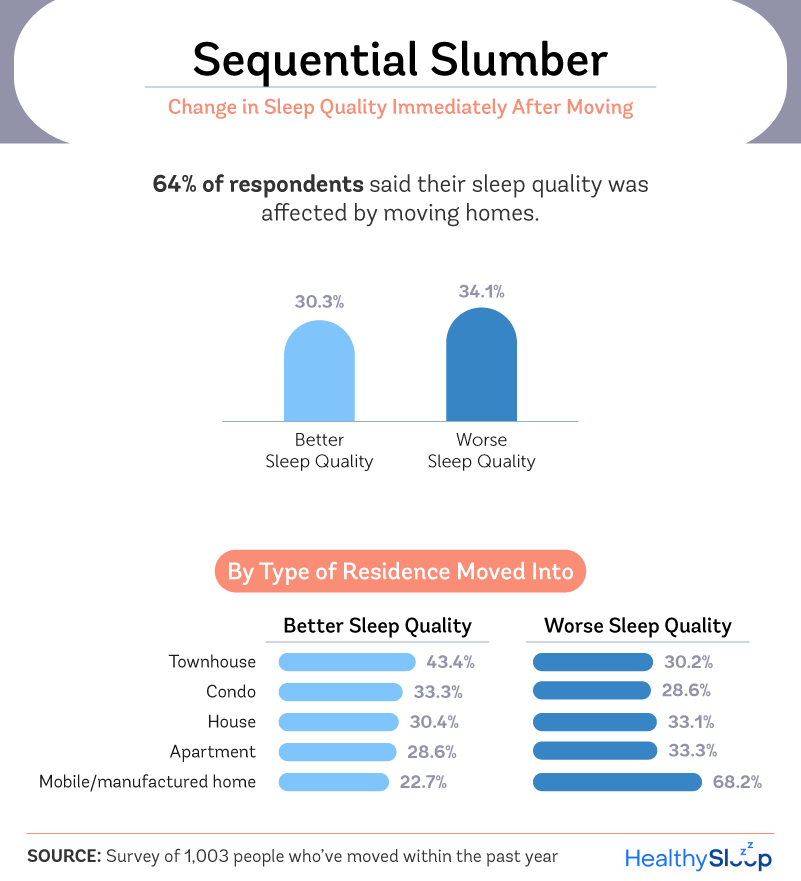
Regardless of the reason behind relocating, moving can bring on stress, which then impacts sleep quality. Overall, 64% of respondents said their sleep quality was affected by moving homes, 30% said they experienced better sleep quality immediately after moving, and 34% received worse sleep altogether. Interestingly, the type of home people relocated to had a significant impact on the quality of sleep. For those reporting a worsening in sleep quality, nearly 70% moved to a mobile or manufactured home. On the flip side, those moving to townhouses were the most likely to report an increase in their quality of sleep immediately after moving.

Reasons Behind Relocating
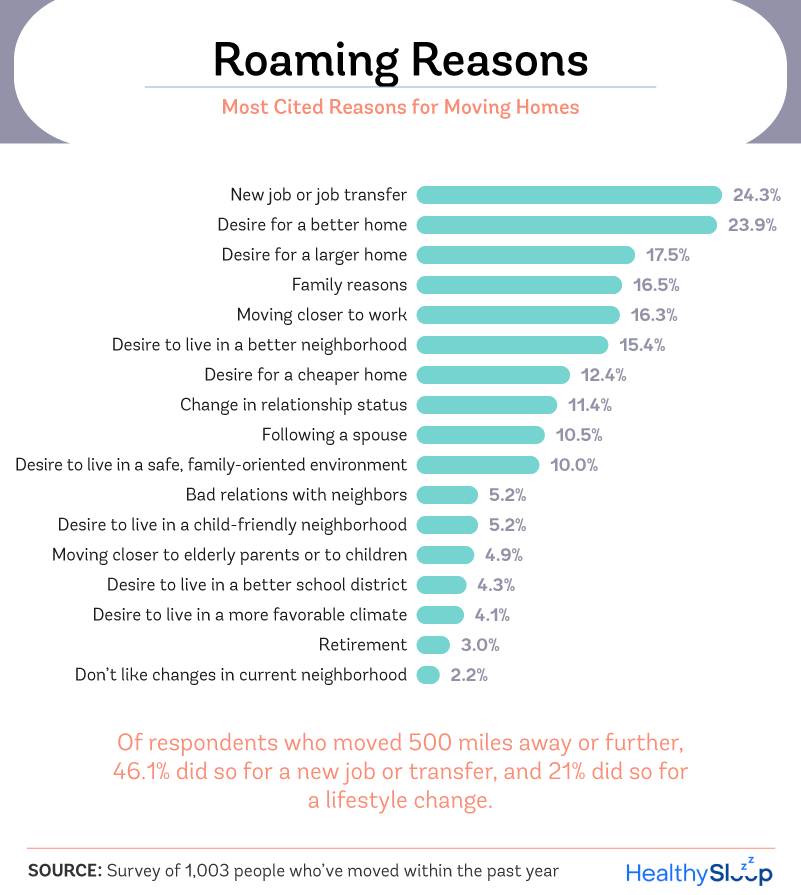
In the late 1980s, more than a third of Americans reported a willingness to leave their homes and relocate for a job. But over the last three decades, the number of people relocating for employment has dwindled. So, why exactly are Americans still on the move? The majority of respondents cited housing-related reasons for their move. This is likely due to the skyrocketing prices of homeownership and the drastic differences found across the states. With 24% moving for a better home and 17.5% moving for a larger home, people are likely taking the price per square foot into consideration – a factor that changes significantly depending on the state.
Moving for job opportunities may be on the decline compared to prior years, but respondents still reported moving for employment-related reasons. A little over 24% reported moving for a new job or job transfer, making it the top reason for relocating, but 16.3% reported moving simply to be closer to work.
Impact of Moving
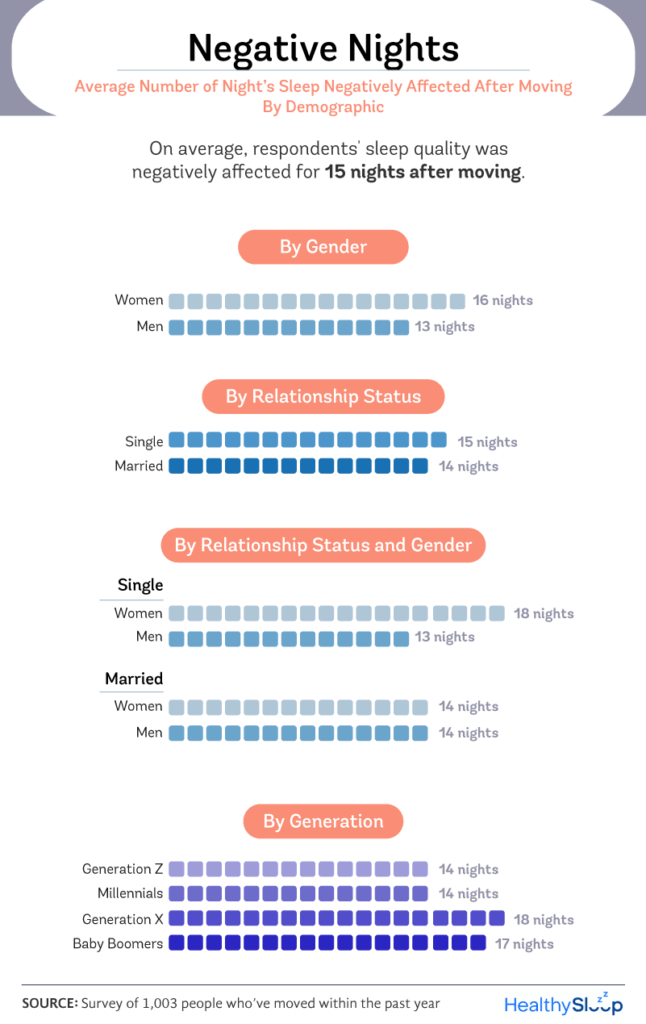
On average, men reported their sleep being negatively impacted for 13 nights immediately after their move, while women experienced a negative impact for an average of 16 nights. Relationship-wise, being married equated to a slightly lowered average number of sleepless nights, with married couples reporting an average of 14 nights, and single people reporting an average of 15.
This isn’t all that surprising, though, considering children aren’t the only ones afraid of sleeping alone. And of adults who fear sleeping alone, women are more affected than men. According to our study, this fear may be heightened after a move – single women reported the greatest number of nights (18 nights) where sleep was negatively impacted immediately after a move.
Baby boomers also struggled to get quality sleep after relocating, with the oldest generation reporting negative impacts for an average of 17 nights. Gen Xers reported losing quality sleep for an average of 18 nights after moving. Just one night of poor sleep can cause significant changes to your brain and body, but after numerous days of poor sleep, it could take weeks to feel fully recovered.
Far From Home

Staying close to home may make the actual move easier, but it doesn’t seem to alleviate all of the negative impacts on sleep. Sixty-five percent of respondents moved less than 50 miles away from their old home, and 84.5% had overall short hauls (that is, those within a 500-mile radius). Still, they averaged 14 nights of negatively impacted sleep, while those who made long-haul moves averaged 18 nights.
Shorter moves didn’t completely eradicate negatively impacted sleep, but those moving shorter distances were significantly more likely to report better or the same quality of sleep. While only 21% of respondents reported better quality sleep after a long-haul move, 32% of short-haul movers reported an increase in sleep quality.

Seventy-three percent of respondents also had their bed set up the same day they moved in, which could help reduce the negative impacts of the change in environment. Having to sleep on the couch, an air mattress, or even the bare floor can be much harder on your body, resulting in frequent disturbances and not-so-fun soreness the next day.
Stressors Preventing Sleep
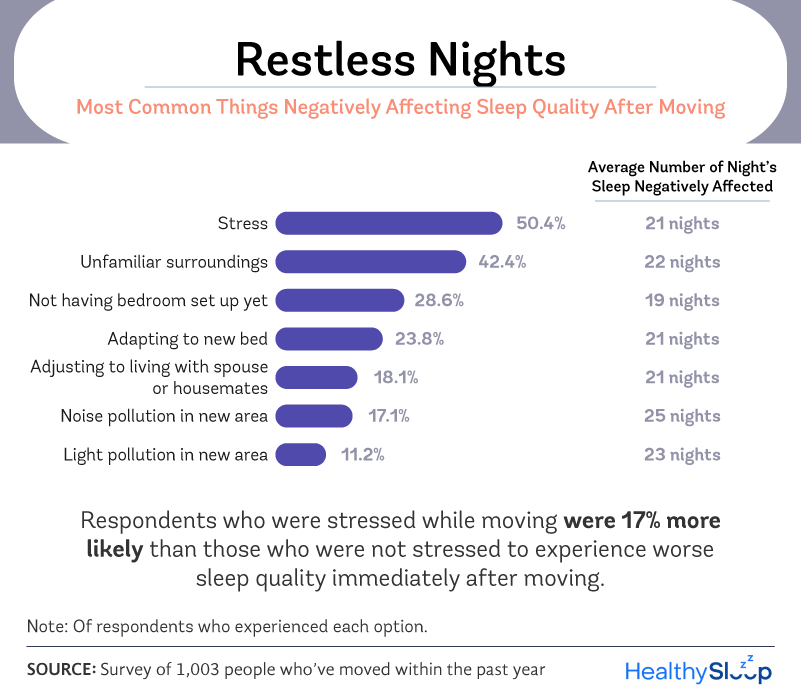
There seems to be a never-ending list of things that can prevent us from getting adequate amounts of sleep. From caffeine and anxiety to noise and lights, our ability to sleep is extremely sensitive. But for people who have recently moved, stress was the No. 1 cause of sleepless nights. Over 50% of respondents pointed to stress as their cause of losing sleep and reported losing sleep for an average of 21 nights. Unfamiliar surroundings were also a major factor in negatively impacted sleep, causing an average of 22 affected nights.
Increased stress can negatively impact the quality and duration of sleep, but lack of sleep can also elevate stress levels. Managing stress before, during, and after the move is one way to prevent sleep disturbances, but participating in stress-relieving activities while in a new home can also ensure adequate rest.
Counting Sheep
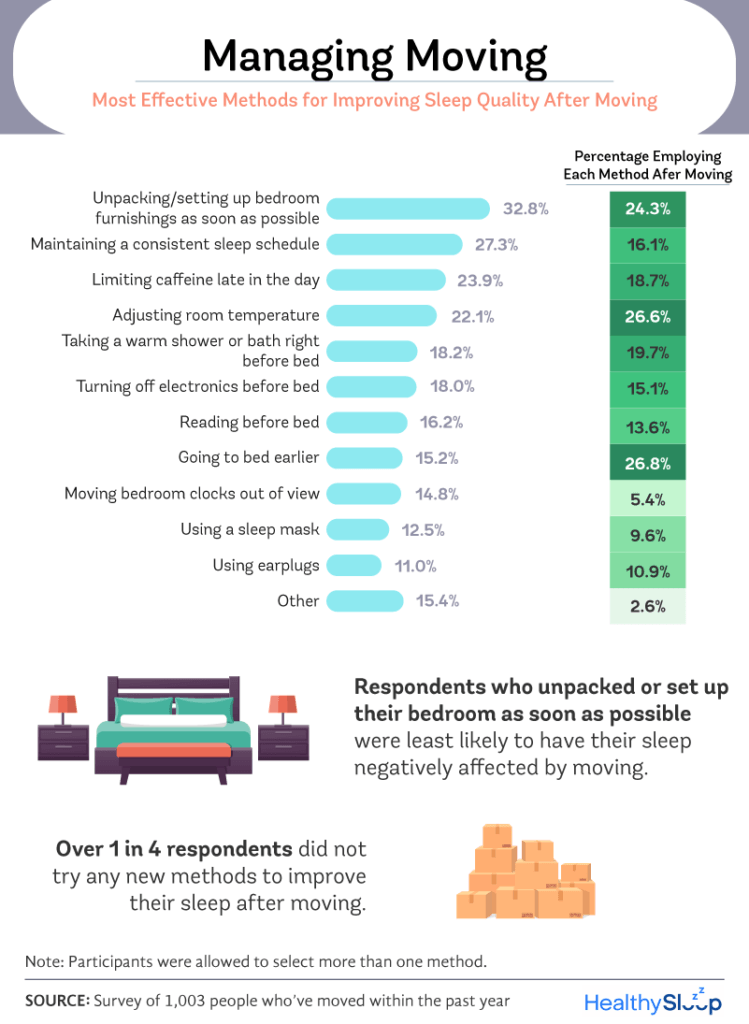
With various ways to mediate stress levels and prevent sleepless nights, which methods are the most common for those who recently moved? According to our respondents, unpacking and setting up the bedroom furnishings as soon as possible was the most effective method for improving sleep quality. While 24.3% of respondents tried out this method after moving, 32.8% said it helped prevent the move from negatively impacting their sleep. Maintaining a consistent sleep schedule was also helpful for around a quarter of the movers who tried this technique, with 16% of total respondents trying this method. Despite all of the possible strategies, 26% of respondents didn’t attempt any new approaches of improving their sleep after moving. Moving management tactics aside, 40% of respondents also reported purchasing a new mattress upon moving in.

Managing Sleep After a Move
Whether you’re relocating for a new job, a new house, or to follow your spouse, moving is the start of a new chapter full of excitement. But before the excitement and relaxation can settle in, the process of moving is often hectic and full of stress. Before all of the boxes are unpacked and furniture is set up, sleep is typically negatively impacted for the first few weeks in a new home.
Trying out new methods to improve sleep quality may be helpful for some, but it can be difficult to know the right way to achieve quality rest for your own body. At Healthy Sleep, we’ve researched various practices from all over the world to figure out which small changes can lead to big differences in sleep. While your mattress plays a major role, your environment and lifestyle are also important factors that shouldn’t be overlooked. To gather recommendations on how to turn your restless nights into restful ones, see some of our latest reads.
Methodology and Limitations
For this study, we used Amazon’s Mechanical Turk to survey 1,003 people in the U.S. who’ve moved within the past year via an online questionnaire. The sample consisted of 428 men, 569 women, and six respondents who identified as neither male nor female. Of our respondents, 711 were millennials, 195 were Gen Xers, and 55 were baby boomers. The remaining 42 participants belonged to either Generation Z or the silent generation. To ensure these data were as accurate as possible, we used an attention-check question to disqualify participants not reading the questions in their entirety. In some cases, questions and answer choices were bucketed and rephrased for clarity or brevity; in all of these cases, the new labels were meant to accurately represent the original intent of the respondents. Long-haul moves were defined as migrating over 500 miles; likewise, migrations less than 500 miles were deemed short-haul moves.
We didn’t have a validated measure to sleep satisfaction so we created our own. To gauge sleep satisfaction, we used a 5-point scale (with 1 being poor sleep and 5 being excellent sleep) for answer options. To determine change in sleep quality after moving, respondents were asked to rate their quality of sleep right before moving and then again immediately after they moved. They were presented with the following scale for both questions:
- Excellent
- Very Good
- Good
- Fair
- Poor
The main limitation of this analysis was that the data were subject to self-reporting. There are several issues with self-reported survey results, which may include but are not limited to the following: exaggeration, attribution, and bias errors. Another limitation was that participants may have experienced difficulty in recalling certain occurrences such as the number of nights their sleep was negatively impacted after moving or the exact distance they moved. All figures were based on estimations. Outliers were excluded where necessary to maintain statistical accuracy, specifically where distance moved and the number of night’s sleep negatively impacted by moving were questioned.
Fair Use Statement
Interested in sharing our findings on sleep quality after a move? The graphics and information from this project are available for non-commercial reuse. Feel free to share them as much as you’d like across the web, on social media, and at work. Just remember to link back to this page to give the authors proper credit.
This article is for informational purposes and should not replace advice from your doctor or other medical professional.
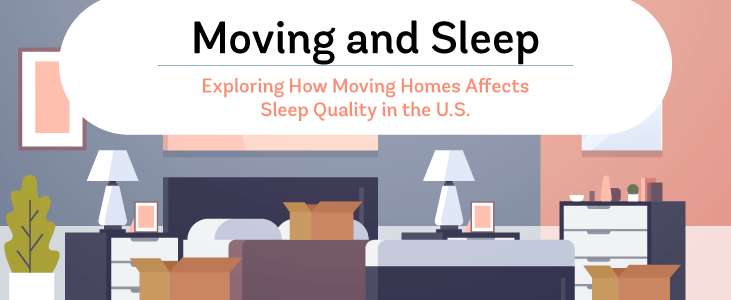
The Conversation (0)
Start a discussion, our content team tries our best to respond to comments. However replies should not be a substitute for medical advice from your doctor.*